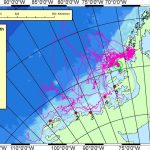← Back
Where do Emperor Penguins moult in West Antarctica?

Moult is a challenging phase in the annual cycle of emperor penguins. It is a time when they must haul out of the ocean, cease eating and rely on their energy reserves whilst their feathers are completely replaced. Understanding the type of habitat they prefer during moult is therefore important for better assessments of the species’ resilience to environmental change. Argos data can help in such studies.
Emperor penguins (Aptenodytes forsteri) are emblematic of the Antarctic and of penguins in general. They are also one of the iconic species mentioned whenever climate change impacts on biodiversity are discussed. This is because of their high dependence upon sea ice, which is vulnerable to environmental warming. They have been studied for some time, at different stages of their lifecycle (see e.g. Argos helps in revealing how juvenile emperor penguins learn to feed).
However, they are not much studied during moult. When penguins undergo moult, their entire plumage is replaced within a matter of weeks (in contrast to flying birds, which replace their feathers gradually). When penguins moult, their plumage is not thermally efficient and is no longer waterproof, so they can’t use the ocean and they can’t forage, making this a challenging phase of their life.
Thus, they must eat beforehand to generate energy reserves, and then find a stable place to stay during the whole moulting period.
Tracking emperor penguins to find where they moult
Adult emperor penguins from Rothschild Island, the most northerly breeding site on the west Antarctic Peninsula, were equipped with Argos tags. This was the first time telemetry data were recorded for emperor penguins breeding in this region, even though this region has been experiencing recent, rapid, regional warming.
Several environmental remote sensing datasets were also used to identify emperor penguin movements and habitat, including a high-resolution coastline, ice concentration, SAR imagery from Sentinel-1 for open water, and sea ice maps.
More info about animal tracking with Argos

Nine of the 33 penguins tracked from Rothschild Island returned to their breeding site, presumably to feed chicks. Eighteen emperor penguins were tracked to their moult sites.
Moulting was assumed when a penguin stopped directional travel, slowed, and remained within a limited area (about 20 km, taking into account uncertainty associated with sea ice movements and ARGOS location uncertainties). These moult areas were located within 100 km of the coast in dense pack ice over the continental shelf.
After the moult, some tags continued transmitting, probably having fallen on sea ice which was drifting.

Conservation concerns
When the penguins were tracked in the summer of 2015/16, the sea ice was more extensive than in recent years (probably in connection with an ongoing El Niño period). Thus, the emperor penguins were not constrained in their choice of moulting locations. However, some of the selected sites on consolidated or perennially persistent pack ice, or fast ice, would not have been available in other years, especially in the most recent years, when the sea ice maximum was much reduced.
The moult period is a critical time for emperor penguins, and will remain so. The six colonies along the west Antarctic Peninsula may suffer due to sea ice loss. Further studies, during years with reduced sea ice extent would facilitate greater understanding about moult habitat selection.

Reference
Trathan, P.N., Wienecke, B., Fleming, A., Ireland, L. Using telemetry data and the sea ice satellite record to identify vulnerabilities in critical moult habitat for emperor penguins in West Antarctica. Polar Biol 47, 533–547 (2024). https://doi.org/10.1007/s00300-024-03252-x



